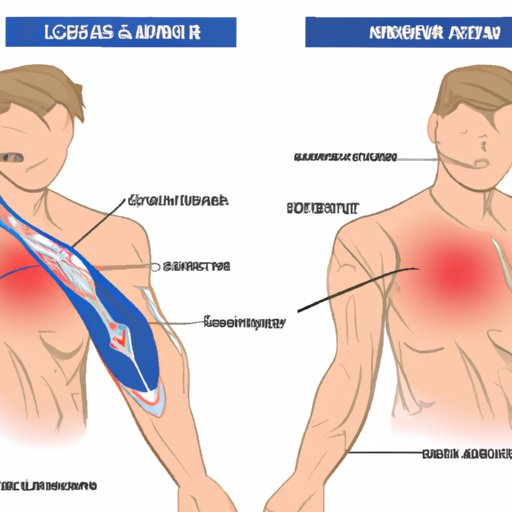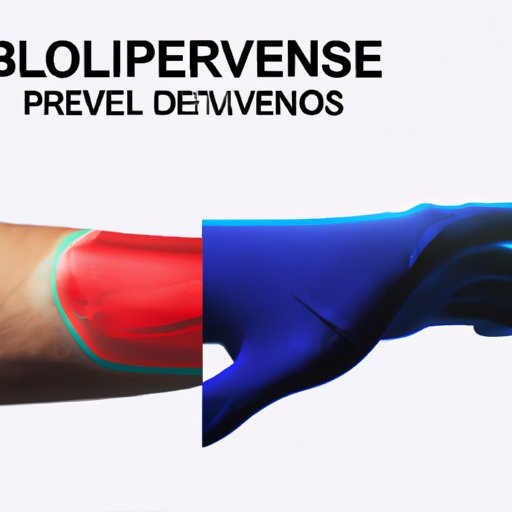
I. Introduction
Have you ever wondered if you can break your elbow? This injury can be painful, debilitating, and interfere with daily activities. In this article, we will explore the anatomy of the elbow joint, how to tell if your elbow is broken, recovering from a broken elbow, preventing future injuries, adjusting to life after the injury, and famous athletes who have overcome this injury. By gaining a better understanding of this condition, you can be better equipped to manage an elbow injury if it ever occurs.
II. The Anatomy of the Elbow: Understanding What Happens When You Break It
The elbow joint is comprised of three bones: the humerus, radius, and ulna. These three bones work together to allow for movements like bending and straightening the arm, as well as rotating the forearm. When a break occurs in any of these bones, it can cause pain and limit mobility in the arm. If the break is severe, it can also cause nerve and blood vessel damage.
To help visualize the injury, diagrams and visual aids are often helpful. The humerus bone extends from the shoulder to the elbow and breaks in the upper arm area. The radius and ulna bones are located in the lower arm and can break in the elbow joint or near the wrist. When a break occurs, it can be either a complete fracture, where the bone snaps completely in half, or an incomplete fracture, where the bone is only partially fractured.
III. How to Tell if Your Elbow is Broken
There are several common signs and symptoms of a broken elbow that you should look out for. These can include:
- Intense pain, especially when moving the arm
- Swelling
- Bruising
- Tenderness to the touch
- Numbness or tingling
- Difficulty bending or straightening the arm
If you suspect that your elbow is broken, it is important to seek medical attention promptly. In the meantime, you can apply ice to the area, keep the arm stable and elevated, and take over-the-counter pain medication to manage the pain.
IV. Recovering from a Broken Elbow: What to Expect
The recovery process for a broken elbow can vary depending on the severity of the injury and the individual’s overall health. Generally, it can take several weeks to months for the elbow to fully heal. During this time, the individual may need to wear a cast or brace to keep the arm stabilized. Physical therapy exercises can also help to rebuild strength and mobility in the elbow joint.
It is important to have realistic expectations for the recovery time. While it may be tempting to rush the process, it is important to allow the elbow to fully heal before resuming normal activities. Engaging in physical activity too soon can re-injure the elbow and extend the recovery time.

V. Preventing Elbow Injuries: Tips and Tricks
There are several effective strategies for preventing elbow injuries. Some of these include:
- Maintaining proper posture at all times, especially during physical activity
- Using proper form and techniques when engaged in physical activities that put pressure on the elbow
- Stretching before activities to ensure that the muscles and tendons in the arm are limber and ready for movement
- Strengthening the muscles and tendons around the elbow joint through targeted exercises
- Wearing protective gear like elbow pads during contact sports or activities
VI. Life After a Broken Elbow: How to Adjust to the Changes
Life after a broken elbow can take some getting used to. Even after the injury has fully healed, there may be some residual pain or stiffness in the arm. Additionally, certain movements or activities that were previously easy may now be challenging. It is important to be patient with oneself during this adjustment period, and work with physical therapists or medical professionals to develop new strategies for accomplishing daily tasks.
It can also be helpful to connect with others who have experienced similar injuries. Support groups, online forums, or speaking with friends or family members who have undergone the injury can provide valuable insight into adjusting to life after a broken elbow.
VII. Common Causes of Broken Elbows and How to Avoid Them
There are several common causes of broken elbows, many of which can be avoided with proper precautions. Some of these causes include:
- Falls onto an outstretched arm
- Direct blows to the elbow joint, such as those commonly sustained during contact sports or fights
- Car accidents or other high-impact collisions
To avoid these injuries, it is important to take the necessary precautions like wearing proper protective gear, avoiding high-risk activities, and practicing safe behaviors during physical activity.
VIII. Famous Athletes Who Overcame Broken Elbows
Despite the challenges of a broken elbow, many athletes have been able to recover and go on to achieve great success in their sport. Some of these athletes include:
- Kevin Love, NBA player for the Cleveland Cavaliers
- Niki Lauda, former Formula One driver
- David Wright, former third baseman for the New York Mets
These athletes were able to successfully recover by taking their time, following their doctor’s orders, and engaging in physical therapy to regain strength and mobility in the elbow joint.
IX. Conclusion
A broken elbow can be a painful and frustrating injury, but with proper care and management, individuals can make a full recovery. By understanding the anatomy of the elbow joint, recognizing the common signs and symptoms of a broken elbow, and taking preventative measures to avoid further injury, individuals can reduce their risk of this injury and successfully recover in the event that it does occur.
If you are currently experiencing a broken elbow, it is important to seek medical attention promptly and follow the advice of your medical professionals. With these strategies in place, individuals can successfully manage this injury and go on to lead healthy and active lives.





